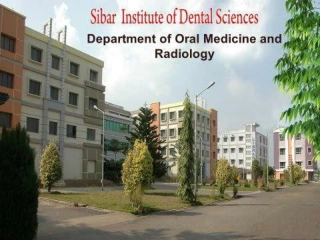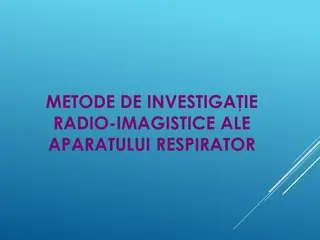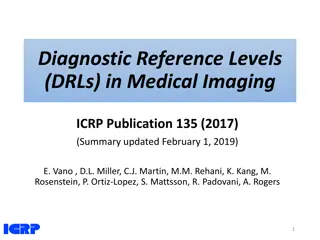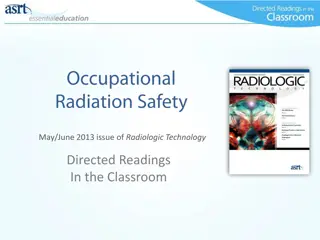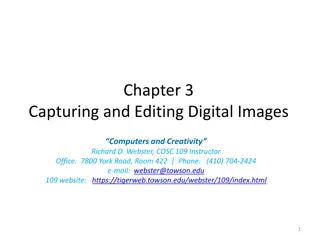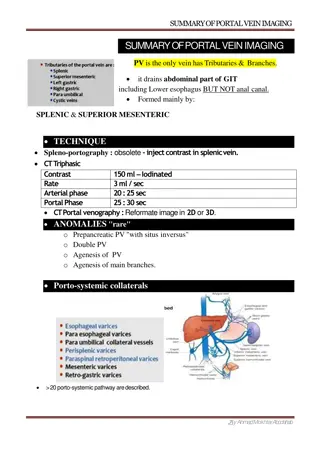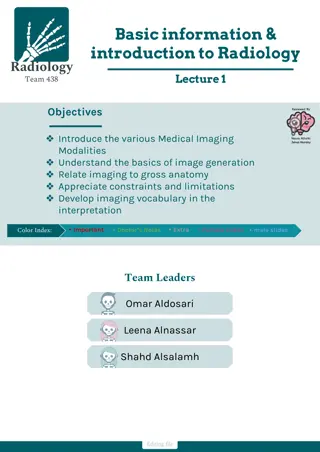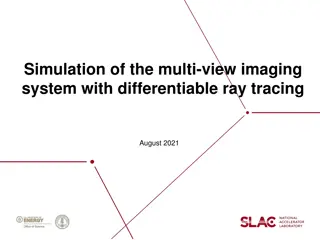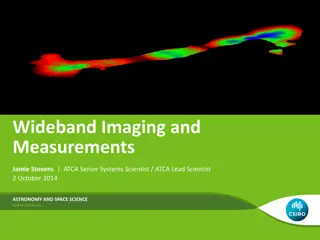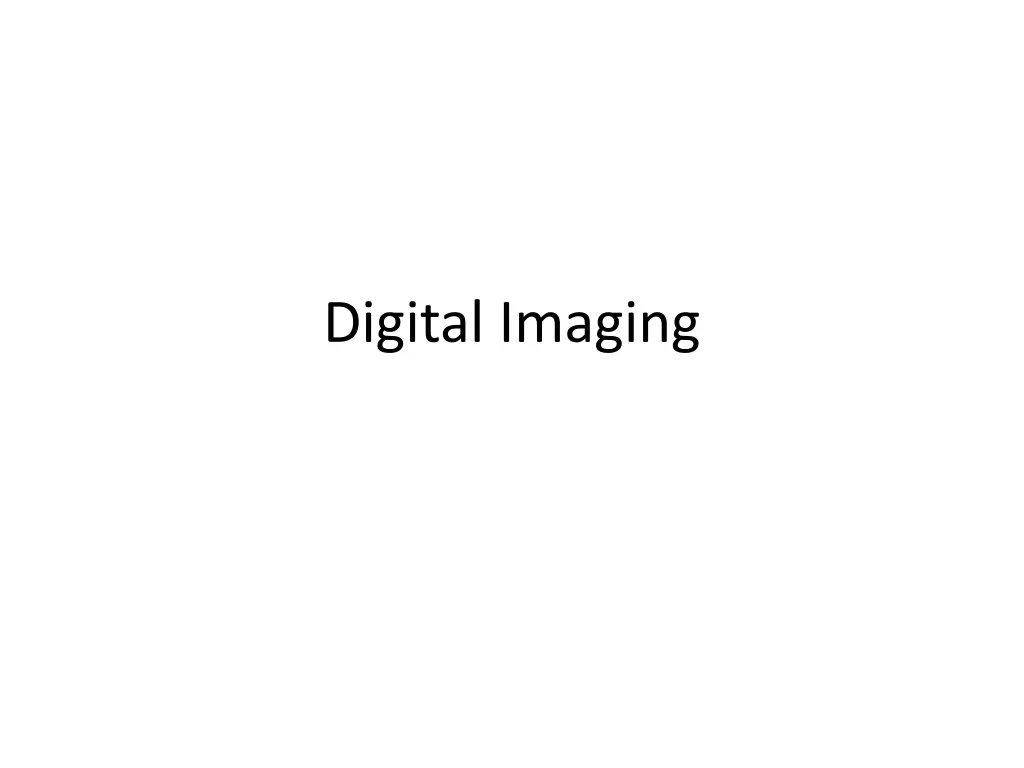
Understanding Digital Imaging and Analog to Digital Conversion
Explore the differences between analog and digital imaging, digital image receptors, solid-state detectors, and charge-coupled devices. Learn about the process of analog to digital conversion, sampling, and quantization in digital imaging technology.
Download Presentation

Please find below an Image/Link to download the presentation.
The content on the website is provided AS IS for your information and personal use only. It may not be sold, licensed, or shared on other websites without obtaining consent from the author. If you encounter any issues during the download, it is possible that the publisher has removed the file from their server.
You are allowed to download the files provided on this website for personal or commercial use, subject to the condition that they are used lawfully. All files are the property of their respective owners.
The content on the website is provided AS IS for your information and personal use only. It may not be sold, licensed, or shared on other websites without obtaining consent from the author.
E N D
Presentation Transcript
Analog versus digital Digital refers to the numeric format of the image content and its discreteness due to 1. Spatial distribution of the picture elements/pixels 2. Different shades of gray of each of the pixels Digital image consists of a large collection of individual pixels organized in a matrix of rows and columns At each pixel of an electronic detector, the absorption of x rays generates a small voltage and is analog signal
Analog to digital conversion Sampling: a small range of voltage values are grouped together a s a single value Quantized: every sampled signal is assigned a value The values are stored in the computer and represent the image The computer organizes the pixels in their locations and displays a shade of gray that corresponds to the number that was assigned during the quantization step.
Digital image receptors 1. Solid-state technology 2. Photostimulable phosphor technology
Solid-state detectors Collect the charge generated by x rays in a solid semiconducting material Matrix and its associated readout and amplifying electronics are enclosed within a plastic housing Most detectors incorporate an electronic cable to transfer data to the computer. Advantage: rapid availability of the image after exposure Disadvantage: miniaturization of electronic components Cable connection can be replaced with RF transmitter, thereby increasing electronic components and increasing overall bulk of sensor.
Charge-Coupled device It uses thin wafer of silicon for image recording Silicon crystals are formed in picture element matrix CCD are more sensitive to light than to x rays, a layer of scintillating material is coated directly on CCD surface or coupled to surface by fiberoptics.
Covalent bonds b/w silicon atoms are broken Electron-hole pairs are produced Exposed to radiation Number of electron hole pairs produced is proportional to amount to amount of exposure an area receives As charge reaches the end of its row, it is transferred to a read out amplifier and transmitted as a voltage to ADC located within or connected to computer The electrons are then attracted to the most positive potential in the device, creating charge- packets Each packet corresponds to one pixels Image is read by transferring each row of pixel charges from one pixel to the next in Bucket Brigade Charge pattern formed from each pixels in matrix represents latent image
Complementary Metal Oxide Semiconductors Are silicon based semiconductors Each pixel is isolated from neighboring pixels and is directly connected to a transistor Electron hole pairs are generated within the pixel in proportion to the amount of x ray energy that is absorbed This charge is transferred to the transistor as a small voltage The voltage in each transistor can be addressed separtely, read by frame grabber and then stored and displayed as a digital gray value
Flat panel detectors Indirect detectors: are sensitive to visible light and an intensifying screen is used t convert x ray energy into light. Direct detectors: uses a photoconductor material, permitting more efficient absorption of x rays. In influence of applied electrical field, the electrons that are freed during x ray exposure of selenium are conducted in a direct line to underlying thin film transistor detector element (TFT). The electrical energy generated is proportional to x ray exposure and is stored at each pixel in a capacitor
Photostimulable Phosphor PSP plates absorb and store energy from x rays and then release this energy as light when stimulated by another light of appropriate wavelength. PSP material used is europium-doped barium fluorohalide Barium in combination with iodine, chlorine or bromine forms a crystal lattice. Addition of europium creates imperfections in the lattice When exposed to energetic source of radiation, valence electrons in europium can absorb energy and move to conduction band
These electrons migrate to nearby halogen vacancies, F- centres in fluorohalide lattice and may become trapped there in metasatable state In this state, number of trapped electrons is proportional to x ray exposure and represents a latent image When stimulated by red light of 600nm, the barium fluoro halide releases trapped electrons to conduction band When an electron returns to Eu+3, energy is released in the green spectrum b/w 300 and 500nm.
Fiberoptics conduct light from PSP plate to photomultiplier tube photomultiplier tube converts light into electrical energy A red filter at photomultiplier tube selectively removes the stimulating laser light, and the remaining green light is detected and converted to a varying voltage Variations in voltage output corresponds to variations in stimulated light light intensity from the latent image The voltage signal is quantified by analog-to-digital converter and stored and displayed as a digital image
Barium fluorohalide material is combined with a polymer spread in a thin layer on a base material to create a PSP Before exposure, PSP plates must be erased to eliminate ghost images from prior exposures and is accomplished by flooding the plate with a bright light.
Digital detector characteristics Contrast resolution Spatial resolution Detector latitude Detector sensitivity
Contrast resolution It is the ability to distinguish different densities in r/g image It is the function of: Attenuation characteristics of tissues imaged Capacity of image receptor to distinguish differences in no of x ray photons coming from different areas of subject Ability of the computer display to portray differences in density Ability of the observer to recognise those differences
Current digital detectors capture data at 8, 10, 12, or 16 bits The bit depth is a power of 2, means the detector can capture 256 to 65536 different densities Computer monitors are capable of displaying a gray scale of only 8 bits and actual no of gray levels is 242 Human visual system is capable is capable of distinguishing 60 gray levels under ideal viewing condition In dental operatory gray levels fall to less than 30
Spatial resolution It is the capacity for distinguishing fine detail in an image Resolution is measured in units of line pairs per mm Atleast 2 pixels are required to resolve a line pair Resolution of PSP plates is influenced by thickness of phosphor material Thick phosphor layers cause more diffusion and a lower resolution resolution is inversely proportional to diameter of laser beam Effective beam diameter is increased by vibration in rotating mirror and drum scanner designs Current PSP plates provide 7lp/mm of resolution
Detector latitude Ability of an image receptor to capture a range of x ray exposures is termed latitude The latitude of CCD and CMOS detectors is similar to that of film and can be extended with digital enhancement of contrast and brightness
Detector sensitivity Sensitivity or spped of a detector is its ability to respond to small amounts of radiation It is affected by detector efficiency, pixel size, and system noise PSP allows 50% dose reductions compared with F films Solid state detectors require less exposure than PSP plates or films
Digital image viewing Cathode ray tube display Thin film transitor display Electronic display considerations Hard copies - Film printers Paper printers Image processing Image restoration Image enhancement brightness and contrast Sharpening and smoothing Color Digital subtraction radiography Image analysis
Cathode ray tube display Computer monitor use cathode ray tube designs A beam of electrons emanating frrom an electron gun rapidly scans a phosphor coated screen The electron scan is horizontal and builds an image line by line The image is repeated or refreshed at a rate of 60 times a second or hertz Color monitor use 3 electron guns for red, blue and green phosphors Variable intensity of electron beam is responsible for different shades of gray or color hue and intensity
High quality monitors are able to display 256 different gray values CRT displays involve conversion of digital information into analog voltages, which are supplied to the electron guns Some image loss occurs in digital to analog conversion dot pitch is a measure of the distance b/w groups of subpixels in CRT Smaller dot pitches provide more pixels per area and sharper looking images The brightness of the monitor affects perceived contrast in image Over time, color phosphors in CRT fade, reducing the brightness of monitor and contrast within the image
Thin film transitor display TFT technology, in laptop and flat panel computer displays Here the signal is sent is sent to the pixels transistot, which inturn causes the associated liquid crystal display to transmit light with an intensity proportional to transistor voltage Subpixels composed of red, blue and green phosphors are subjected to varied voltages and in combination create a pixel output of a particular hue and intensity
Electronic display considerations Quality, capabilities and ease of use of display software varies Display of images vary depending on how software handles resizing of windows or the size and resolutions of different displays bright background illumination from windows or other sources of ambient light reduces visual contrast sensitivity light reflecting off a monitor surface may further reduce the visibility of image contrast Images are best viewed if lighting is subdued and indirect
Hard copies Printed image should provide adequate image quality to prevent loss of diagnostic information There should be sufficient assurance that the diagnostic information be retained quality is influenced by printing technology, printer quality, printer settings and type of media Printing technologies include laser, inkjet and dye sublimation with use of film or paper
Film printers High quality film printers that use laser or dye sublimation are expensive Low cost alternatives suffer a reduced diagnostic quality Current film transparencies produced with ink jet technology appear to be suboptimal for tasks such as caries diagnosis
Paper printers Paper printed digital radiographs require reflective light from a normally lit room

